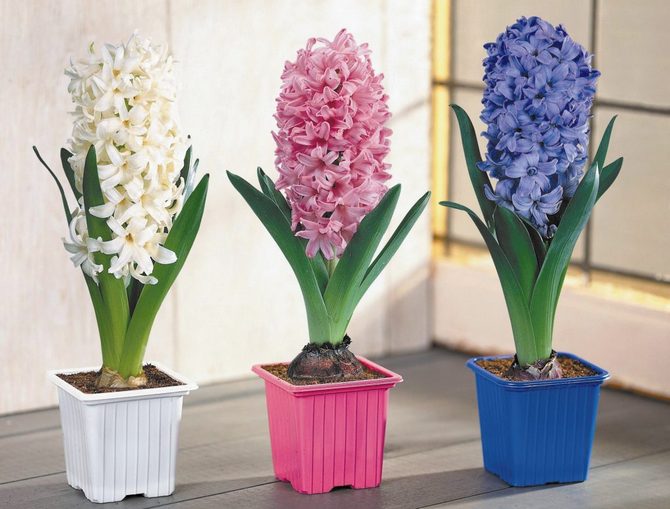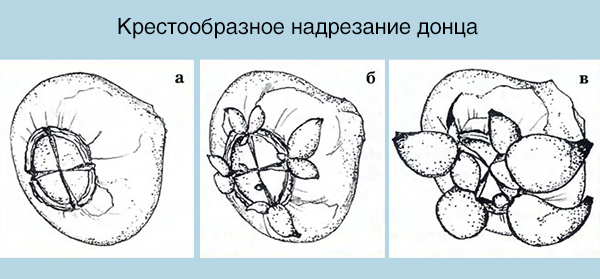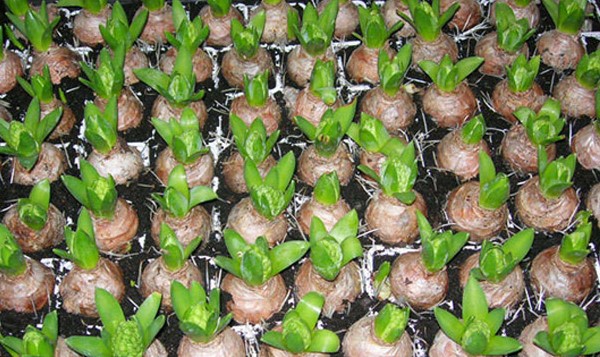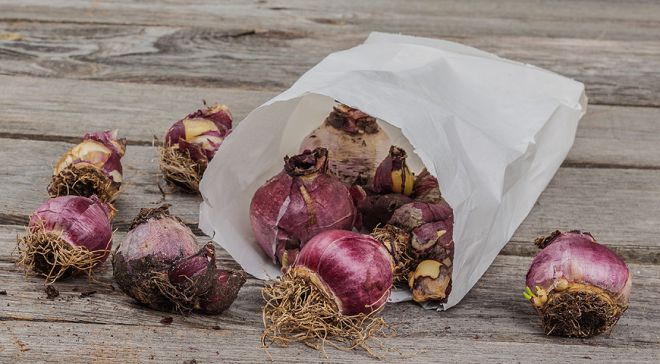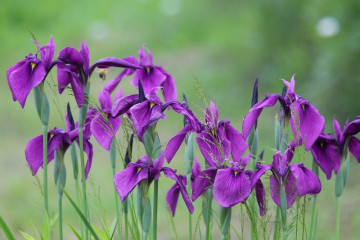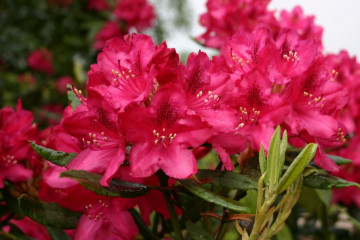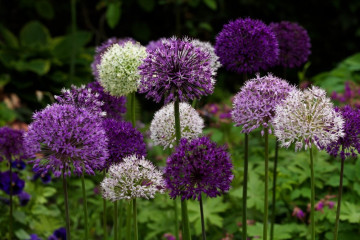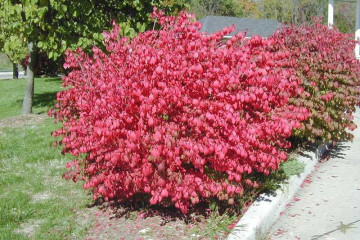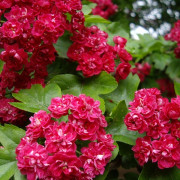Hyacinths: planting and care in the open field
Content:
- How to choose and prepare bulbs
- Choosing a place for hyacinths in the garden
- Planting timing and soil preparation
- How to propagate hyacinths at home
- Forcing in pots with soil
- Hyacinth care in the garden
- Hyacinth transplant after flowering or purchase
- Storing hyacinth bulbs
- The main pests and diseases of hyacinths
By March 8, shops are starting to sell beautiful bulbous flowers - hyacinths. After purchasing them, many want to preserve them and grow them on their own. Not everyone knows how to preserve the bulb and achieve re-flowering.
How to choose and prepare bulbs
Before growing hyacinth in the garden, it is important to learn how to select healthy and strong tubers. For planting in the ground or a pot, take medium-sized hyacinths. They must be tight and free from damage.
The scales on the surface of the bulb should adhere tightly to each other, their color should be darker than the color of the flower.
How to determine the age of a hyacinth by bulb size
| Bulb size | Age |
|---|---|
| 2-3 cm | Young, just formed from children |
| 4-5 cm | Adults producing good stalks |
| 6-7 cm | Old bulbs in need of renewal |
Before planting, the planting material is examined, dried scales are removed. Immediately before planting, hyacinths must be disinfected in a weak solution of potassium permanganate or a purchased fungicide.
Choosing a place for hyacinths in the garden
To grow these flowers in the country or near the house, choose an open area, protected from drafts. The plant should receive a lot of sunlight, but the direct rays of the sun can harm it.
Flowers are allowed to be planted under tall trees, but in this case more fertilizers will need to be applied. The flower bed is placed on a hill or a small slope. The surface of the earth is leveled.
Hyacinths grow well in organic-rich soil. The soil should be light, moisture permeable. The landing site is prepared 2-3 months before it.
Planting timing and soil preparation
When to plant hyacinths, many gardeners are interested. It is better to do this in the fall, in the last week of September - the first week of October. An earlier or later planting will lead to the death of the plant.
A flower bed is prepared 2 months before the expected date of planting hyacinthus bulbs. The selected place is dug to a depth of at least 40 cm, organic fertilizers (for example, humus or compost), potash and phosphorus fertilizers are applied.
Sand should be added to heavy soils, lime, chalk or ash should be added to highly acidic soils. The prepared bed is covered with a dark film or boards. Such a measure will prevent the appearance of weeds in the flower bed.
How to plant hyacinths in the spring in the garden
In spring, hyacinth bulbs are rarely planted. Most often, hyacinths bought in a store are taken for planting in open ground in the spring. These flowers should be planted following the steps below:
- When the hyacinth has faded, the peduncle is removed.
- The plant, along with an earthen clod, is taken out of the pot.
- A hole is made in the previously prepared soil to the depth of the pot.
- Sand is poured at the bottom of the hole as drainage.
- Put the hyacinth bulb together with the earthen clod in the hole and cover with soil.
- Water the plant around, being careful not to wet the bulb itself.
In the event of a threat of spring frosts, the planted flowers are covered with non-woven material.
Rules for planting hyacinths in the fall
In autumn, hyacinths are planted in late September - early October. A flower bed is prepared for planting at least 10 days in advance. After the earth has settled, holes are made for each plant. Sand is poured at the bottom of the recess, and an onion is placed. Around it, a sand pillow is made no more than 1.5 cm in thickness. Fertile soil is poured on top.
After planting in dry soil, the plants are watered. If the soil is wet, then watering is not needed. You can plant tubers in a common garden bed, but in this case more sand will be needed. It is more expedient to make individual holes for planting in a large flower bed. When all the plants are planted, the flower bed is mulched with peat, straw or sawdust.
It is important to determine exactly when to plant hyacinths outdoors. When planted early, the plant will germinate and the young shoot will freeze. If you delay planting on the garden plot, then the tuber will not have time to take root and will die when frost sets in.
How to propagate hyacinths at home
Hyacinths can reproduce both by seeds and by parts of a plant. Planting seeds is used only for breeding purposes. This is a long and laborious process. Vegetative reproduction is more often used.
During the digging of the bulbs for storage, babies can be found on them. Well-formed babies are separated from the mother plant and stored separately. In the fall, they are planted at the same time as the adult flowers.
Cutting the bottom of the hyacinth bulbs
The largest and healthiest bulbs are selected from the planting material. After cleansing from the soil, they are dried in a warm place for a week. After the roots dry up and can be easily removed, the bottom can be cut out.
To remove the bottom of the hyacinth bulb, use a scalpel, penknife or copulation knife. Some growers can carry out this operation with a teaspoon with a sharpened edge.
The bottom is cut out in the form of a funnel: from the outer ring to the middle. During the procedure, do not damage the outer ring and scales of the bulb. After processing, the slices are sprinkled with chopped charcoal, and the knife is disinfected.
Processed bulbs are placed in a box of damp sand with the cut-out facing up. You need to store them in a warm, dark place, covered with foil. After 2-3 months, babies are formed, after a month they reach 10 mm in size.
When the babies are formed, they, together with the uterine bulb, are transplanted into the garden, deepening so that there is a layer of soil 10 cm thick above them, the planting is covered with mulch on top.
The next year, mothers and babies feed well, water and weed the garden. Thoroughly cover for the winter. A year later, at the end of July - beginning of August, they are dug up, separated from the large onion and planted in a permanent place. The tubers obtained in this way bloom for 3 years.
Cutting the bottom of the hyacinth bulbs
Notching the bottom is easier than the previous method of breeding hyacinths, but it produces fewer babies. But they are larger than the children obtained by cutting out the bottom.
For this method, take young bulbs, dry them well. A cruciform incision is made at the bottom.Its depth should not exceed 0.6 cm. During the day, the slices are allowed to dry in a warm and dry place. The next day they are placed in a box of sand and germinated as in the previous breeding method.
Forcing in pots with soil
For forcing in winter, large bulbs are selected without damage. Only those grown in the garden are taken. Selected bulbs are planted in pots in October - November.
The soil for distillation is taken light. To improve air permeability, it must necessarily contain sand. It is better to plant hyacinths in separate containers.
Planted pots are covered with paper bags or other pots. You can use dark plastic bags with holes. The planted hyacinths are stored in a dark place at a temperature of 5-8 ° C for at least 10 weeks. When the soil in containers dries up, the plants are moderately watered with cold water. The earth ball should always be moist.
After the sprouts appear at the end of the dormant period, the cover is removed and the flower pots are transferred first to a room with a temperature of 10-15 ° C, then to a warmer and lighter room. Hyacinths begin to bloom 3-4 weeks after transfer.
Hyacinth care after distillation consists in regular watering and fertilizing with mineral fertilizers for flowering plants.
Hyacinth care in the garden
Everyone who wants to grow them needs to know how to care for hyacinths. Hyacinth care is as follows:
- watering;
- top dressing;
- weeding;
- loosening.
To prevent rapid evaporation of moisture and germination of weeds, flower beds are mulched after planting. This measure will help to avoid frequent loosening of the soil near the plants.
Watering
Hyacinths are sensitive to excess moisture. Water them in moderation and in small quantities. Often, watering a garden with these spring flowers is necessary only during the period of bud formation and flowering. The rest of the time, watering is small.
Fertilizers
Hyacinth bulbs live up to 7 years, so it is important to provide them with nutrients. Different fertilizers are used depending on the growth phase of the flower.
In the spring, after the leaves appear, the flowerbed is watered with a solution of nitrogen-containing fertilizers. It can be urea or ammonium nitrate.
After the buds appear, fertilizers containing potassium and phosphorus are applied. For example, superphosphate and potassium chloride. After the end of flowering, superphosphate and ash are added.
Preparation for wintering
After planting the bulbs in the garden, the flower bed is watered. If it rains a lot in the fall, then the natural moisture is enough for the hyacinths to root. Preparation for winter consists in creating an optimal temperature regime around the bulbs. For this, mulch is used. It can be made from compost, leaves, or straw. The layer should be at least 20 cm. This will protect the tubers from frost.
In Siberia and the Urals, the land freezes more than in the central zone of Russia. Therefore, for the winter, hyacinth bulbs are dug up and stored until spring.
Hyacinth transplant after flowering or purchase
When to transplant hyacinths, the plants themselves will tell you. Yellowing and wilting of leaves serve as a signal to dig up the bulbs. Care should be taken when removing hyacinths from the ground. The shovel is placed 10 cm from the flower and sunk into the ground for the entire bayonet. The dug out bulbs are cleaned from the ground and washed. After examination, whole healthy specimens are left.
Selected plants are placed in a solution of potassium permanganate or foundationol for disinfection. After processing, the tubers are dried. Before storage, dried scales are removed from the bulbs. The prepared planting material is placed in boxes or bags and placed in a warm, dry place until autumn.
The first month the bulbs are stored at a temperature of + 25-30 ° С, in the following months it is lowered to + 17 ° С.
Storing hyacinth bulbs
Storage varies between purchased flowering plants and those grown on the plot. In the first case, after flowering, the peduncle is cut off. If the plant grew in a small container, then it is transplanted into a larger pot. After pruning the peduncle and transplanting, the hyacinth is placed in a cool, lighted place. It can be placed against the glass of the window. There he will have enough light, and the temperature will be low.
Watering hyacinth in storage should be done in moderation. In May - June, the preserved bulb is transplanted into a flower garden.
Plants growing in the garden are dug up after flowering and replanted in the fall before winter. In summer, the bulbs are stored in a cool, dark place.
The main pests and diseases of hyacinths
Growing and caring for hyacinth in the open field is impossible without knowledge of pests and flower diseases.
Code of pests and diseases of the flower
| Pests / disease | Signs | Treatment method |
|---|---|---|
| Flower fly | Growth slows down, leaves wither | Treatment of plants with preparations "Mukhoed", "Aktara" or "Tabazol" |
| Aphids and thrips | Leaves turn yellow, flowers do not develop and fall off | Hyacinth care involves treatment with aphicide |
| Medvedka | The plant withers, the dug out bulbs are badly damaged | When planting, corrugated board or slate 20-25 cm wide is buried around the flower bed |
| Apical flowering | A short inflorescence is formed, the upper flowers bloom before the lower ones | Compliance with the storage temperature |
| Peduncle Top Rot | The top of the peduncle rots during germination | Grow at lower temperatures |
| Yellow bacterial rot | Yellow spots appear along the veins on the leaves and peduncle. The same spots form on the bulb, gradually decaying | Destruction of bulbs, cultivation of soil with bleach. It will be possible to plant hyacinths in this place only after 3-4 years. |
| Soft bacterial rot | The plant turns yellow, does not develop, withers. The bulb is rotting | Store and grow in low humidity, dry the bulbs well. Affected bulbs are destroyed |
Planting and caring for hyacinths in the open field, which require knowledge of the cultivation characteristics, will bring many pleasant moments. Compliance with the rules for growing hyacinths, caring for them and storing them will allow any gardener to decorate their site with beautiful hyacinth caps.
